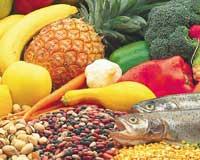Feeding during pregnancy and lactation
The woman needs an average of 2,300 kilocalories per day, and during pregnancy, especially in the second part, it is recommended to increase between 250 and 300 kilocalories per day to cover the needs of the newborn. During breastfeeding, energy needs are higher and more than 500 kilocalories are needed per day.

The woman's body needs 700 kilocalories to produce a liter of milk, but as in pregnancy fat accumulates, it should not be taken so much. In addition to increasing the amount of energy, the mother should consume more protein foods. In addition, other nutrients are of great importance and require special attention:
- Folates: because of their absence, the vertebral column and the brain of the embryo are not formed properly. Deficiency may be due to insufficient intake of folic acid or vitamins B6 and B12. Therefore, especially before becoming pregnant and during the first three months of pregnancy, foods with folic acid such as spinach, peas, asparagus, broccoli and fungi should be taken.
- Iron: Increasing the amount of blood increases the iron needs. But if the warehouses are well saturated before becoming pregnant, surely there will be no problem. However, during pregnancy it is good to consume foods containing heme iron (contained in animal foods): red meat, mussels, clams... Pistachios, legumes, spinach, etc. They are also rich in iron.
- Calcium: increases considerably the need for calcium during pregnancy and lactation. On the one hand, it is needed to properly complete the bones of the child and, on the other, the needs of the mother should be met as in a normal situation. Under normal conditions, the woman needs 800 mg of calcium, but during pregnancy you have to add 600 mg of calcium per day and 700 mg of lactation. In the third trimester of pregnancy, the child needs 300 mg of calcium to complete his bones.
The wisdom of the human body makes that in these vital moments the body adapts to take advantage of all the resources offered by food and thus avoid shortages. For example, the intestines absorb more calcium, as it increases the influence of estrogens and vitamin D.
During pregnancy, most food care is aimed at avoiding problems of muscle relaxation of the digestive system, especially nausea and constipation. To avoid morning sickness, it is recommended to eat and drink solid foods before getting up, although sometimes these measures are insufficient. To avoid constipation problems, it is recommended to take more food with fiber and drink two liters of water a day.

During breastfeeding, a balanced diet will ensure good milk production, there are no magic formulas, although there are some guidelines. It is important to drink enough liquid during the day (water, juices, milk, etc. ). On the other hand, some foods increase milk production, such as brewer's yeast and millet. Other foods alter the color and flavor of the milk, among which are the onion, leek, artichoke, asparagus, garlic, cauliflower, berza and legumes, means that they cannot be eaten.
Gestational diabetes managementDuring pregnancy it is common to increase blood glucose levels: between 8 and 10% of pregnant women suffer from this problem. Early detection takes place between week 24 and 28 of pregnancy by measuring blood glucose levels, first fasting, and then one hour after taking a solution of 50 g of glucose. If it is more than 140 mg, the test is repeated by analyzing the glucose level that occurs in one hour, two hours and three hours. On many occasions, this woman has had no previous problems with diabetes and is likely to recover glucose levels at the end of her pregnancy. However, it is true that the chances of developing gestational diabetes are greater in cases of family problems of obesity and diabetes. A woman's baby with gestational diabetes is usually older than usual and if she is not born before week 40 of pregnancy, childbirth occurs. If this problem is detected, the woman has to adapt the eating habits while it is recommended to exercise more often to better control blood glucose levels. In general, the characteristics of the diet should be:
From these guidelines will be elaborated weekly menus adapted to the customs of each woman. Always with a personalized diet. Following these tips, it is possible to control blood glucose levels by performing a physical exercise adjusted to the circumstances. If with these two measures the disease is not controlled, it will be time for the treatment of insulin, but always by medical decision. |
Buletina
Bidali zure helbide elektronikoa eta jaso asteroko buletina zure sarrera-ontzian











